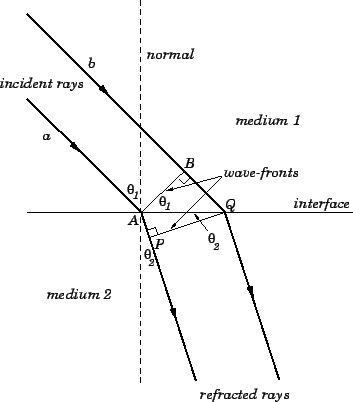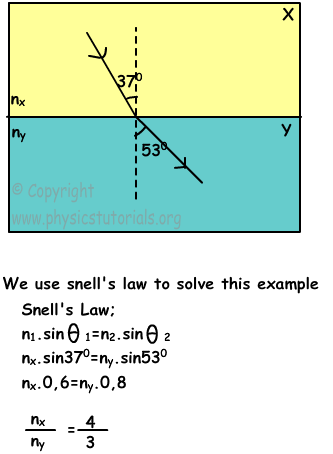state laws of refraction
Law of Refraction
The law of refraction, which is generally known as Snell's law, governs the behaviour of light-rays as they propagate across a sharp interface between two transparent dielectric media.
Consider a light-ray incident on a plane interface between two transparent dielectric media, labelled 1 and 2, as shown in Fig. 57. The law of refraction states that the incident ray, the refracted ray, and the normal to the interface, all lie in the same plane. Furthermore,
| (341) |
where ![]() is the angle subtended between the incident ray and the normal to the interface, and
is the angle subtended between the incident ray and the normal to the interface, and ![]() is the angle subtended between the refracted ray and the normal to the interface. The quantities
is the angle subtended between the refracted ray and the normal to the interface. The quantities ![]() and
and ![]() are termed the refractive indices of media 1 and 2, respectively. Thus, the law of refraction predicts that a light-ray always deviates more towards the normal in the optically denser medium: i.e., the medium with the higher refractive index. Note that
are termed the refractive indices of media 1 and 2, respectively. Thus, the law of refraction predicts that a light-ray always deviates more towards the normal in the optically denser medium: i.e., the medium with the higher refractive index. Note that ![]() in the figure. The law of refraction also holds for non-planar interfaces, provided that the normal to the interface at any given point is understood to be the normal to the local tangent plane of the interface at that point.
in the figure. The law of refraction also holds for non-planar interfaces, provided that the normal to the interface at any given point is understood to be the normal to the local tangent plane of the interface at that point.
By definition, the refractive index ![]() of a dielectric medium of dielectric constant
of a dielectric medium of dielectric constant ![]() is given by
is given by
| (342) |
Table 4 shows the refractive indices of some common materials (for yellow light of wavelength ![]() nm).
nm).
|
The law of refraction follows directly from the fact that the speed ![]() with which light propagates through a dielectric medium is inversely proportional to the refractive index of the medium (see Sect. 11.3). In fact,
with which light propagates through a dielectric medium is inversely proportional to the refractive index of the medium (see Sect. 11.3). In fact,
| (343) |
where ![]() is the speed of light in a vacuum. Consider two parallel light-rays,
is the speed of light in a vacuum. Consider two parallel light-rays, ![]() and
and ![]() , incident at an angle
, incident at an angle ![]() with respect to the normal to the interface between two dielectric media, 1 and 2. Let the refractive indices of the two media be
with respect to the normal to the interface between two dielectric media, 1 and 2. Let the refractive indices of the two media be ![]() and
and ![]() respectively, with
respectively, with ![]() . It is clear from Fig. 58 that ray
. It is clear from Fig. 58 that ray ![]() must move from point
must move from point ![]() to point
to point ![]() , in medium 1, in the same time interval,
, in medium 1, in the same time interval, ![]() , in which ray
, in which ray ![]() moves between points
moves between points ![]() and
and ![]() , in medium 2. Now, the speed of light in medium 1 is
, in medium 2. Now, the speed of light in medium 1 is ![]() , whereas the speed of light in medium 2 is
, whereas the speed of light in medium 2 is ![]() . It follows that the length
. It follows that the length ![]() is given by
is given by ![]() , whereas the length
, whereas the length ![]() is given by
is given by ![]() . By trigonometry,
. By trigonometry,
 | (344) |
and
 | (345) |
Hence,
| (346) |
which can be rearranged to give Snell's law. Note that the lines ![]() and
and ![]() represent wave-fronts in media 1 and 2, respectively, and, therefore, cross rays
represent wave-fronts in media 1 and 2, respectively, and, therefore, cross rays ![]() and
and ![]() at right-angles.
at right-angles.
When light passes from one dielectric medium to another its velocity ![]() changes, but its frequency
changes, but its frequency ![]() remains unchanged. Since,
remains unchanged. Since, ![]() for all waves, where
for all waves, where ![]() is the wavelength, it follows that the wavelength of light must also change as it crosses an interface between two different media. Suppose that light propagates from medium 1 to medium 2. Let
is the wavelength, it follows that the wavelength of light must also change as it crosses an interface between two different media. Suppose that light propagates from medium 1 to medium 2. Let ![]() and
and ![]() be the refractive indices of the two media, respectively. The ratio of the wave-lengths in the two media is given by
be the refractive indices of the two media, respectively. The ratio of the wave-lengths in the two media is given by
 | (347) |
Thus, as light moves from air to glass its wavelength decreases.







.png)
.png)